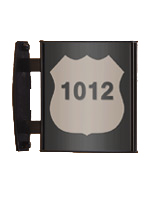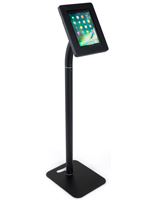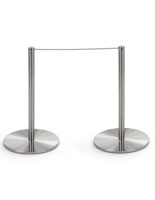
Posted on 14, June, 2023
Last Modified on 21, June, 2023
Shop Products from This Article
ADA Compliant Signage: Make a Strong First Impression

Your business signage is the first point of contact for potential customers. By ensuring your signage is ADA compliant, you not only project a professional image but also create an inclusive environment. According to ADA.gov, ADA signage should feature easy-to-read fonts, proper color contrast, and if possible, Braille translations. This means that your signage should be legible for a wide range of customers. Your signage should also be mounted at the proper height and angle for easy visibility and accessibility. These modifications enable visually impaired individuals to navigate your premises independently and feel welcomed, enhancing their overall experience and boosting your business's reputation as an inclusive establishment.
For tips on how to hang ADA-compliant signage, read our guide!
Accessible Kiosks: Meeting Height & Reach Standards

Displays that meet both height and reach standards are an essential part of creating an ADA compliant shopping environment. Floor standing and wall mounted self-service kiosks have become an integral part of the shopping experience. ADA compliant kiosks are designed with thoughtful considerations, including accessible heights and reach ranges for individuals in wheelchairs, tactile and audible feedback for those with visual impairments, and intuitive interfaces for users with cognitive disabilities. By implementing kiosks with ADA compliant features, retail stores can empower shoppers of all abilities to navigate and engage with the kiosk independently, ensuring equal access to information, services, and transactions. This commitment to inclusivity not only enhances the overall customer experience but also reflects the values of your business in creating a truly accessible environment for all.
Download our Height & Reach Standards infographic here for more info.

Discernable Crowd Control: Cane-Detectable Stanchions & Barriers

Your crowd control and barriers should involve the utmost consideration for ADA compliance for individuals with visual impairments or those who rely on canes for navigation. Compliant stanchions should feature a maximum belt height of 27" from the floor surface and have a durable weight to withstand bumps and impacts without be knocked over or easily moved out of place. With our cane-detectable stanchions, you can create a safe and inclusive environment, enhancing navigation and crowd management while prioritizing the needs of all visitors at your trade show, event, or in your retail location.
Retail/Merchandising Displays: Maximize Accessibility and Customer Engagement
The arrangement of merchandise and displays plays a significant role in attracting customers and promoting sales. By incorporating ADA-compliant principles into your retail displays, you can create an accessible and engaging shopping experience for all customers. Optimize aisle widths to accommodate wheelchairs or mobility aids, ensuring that products are within reach for individuals with different abilities, and using clear signage to indicate accessible pathways. By following ADA guidelines , you not only cater to a broader customer base but also improve overall traffic flow and enhance the shopping experience for everyone.
You should consider the traffic flow of your store to best optimize your store’s layout for all types of accessibility. Consider customers of all types that will need both visible and physical accessibility to be able to shop accordingly and access your merchandise effectively. Ensure adequate lighting and signage labels throughout your store and provide written and visual aids to help shoppers find and select products. Displays that are best suited for ADA accessibilty are customizable displays like slatwalls or gridwalls. Using provided and available accessories for the floor standing or wall mounted displays, you can customize your merchandising layout to accommodate customers. These customizable merchandisers allow you to learn what layouts work best for your customers and how to best optimize their shopping experience.
Physical Accessibility: Welcoming All Customers
One of the fundamental aspects of ADA compliance is ensuring physical accessibility throughout your business premises. Install ramps or other means of accessibility to provide avenues to individuals with mobility challenges. Designate accessible parking spaces close to the entrance, with proper signage and compliant pavement markings. Additionally, ensure that doorways and hallways are wide enough to accommodate wheelchairs or mobility aids comfortably. These adjustments not only demonstrate your commitment to inclusivity but also make it easier for all customers to navigate your establishment, fostering a positive and inclusive environment, turning over more sales, and providing your retail location with a higher reputation.Other ADA Compliant Specifications
Beyond signage, retail displays, and physical accessibility, there are several other ADA compliant specifications that you should consider implementing. These include:- Website Accessibility: Ensure your business website is accessible for individuals with visual or hearing impairments. Provide alternatives to multimedia content, include descriptive alt tags for images, offer captions for videos, and allow site readers to read all content on your web pages.
- Assistive Technology Compatibility: Train your staff to be familiar with all in-store technologies and equipment, such as screen readers, signage and direction info, and general store knowledge, so they can provide assistance if needed. If your store is equipped, make sure your digital kiosks are accessible with screen readers and audio to help visually impaired shoppers enjoy a positive experience.
- Training and Sensitivity: Educate your staff about ADA compliance, disability etiquette, and the importance of providing excellent customer service to individuals with disabilities. Encourage a culture of empathy and respect to include all customers and
Creating Inclusive Shopping Spaces
ADA compliance is not just a legal obligation but a significant opportunity for business growth, inclusivity, and maximizing your brand outreach. By incorporating ADA-compliant signage, retail/merchandising displays, physical accessibility options, and other honorable mentions, you create an environment that welcomes and serves individuals with disabilities and other impairments. Enhance your business's reputation and foster customer loyalty by going above and beyond legal requirements, demonstrating your commitment to inclusivity andpositioning your business as a leader in providing a positive, accessible customer experience.


